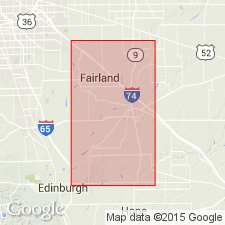
- Usage in publication:
-
- Geneva limestone
- Modifications:
-
- Original reference
- Dominant lithology:
-
- Limestone
- AAPG geologic province:
-
- Cincinnati arch
Summary:
Pg. 63, 81, 82. Geneva limestone. Buff magnesian limestone (Corniferous), 38 feet thick, at top of Devonian in Shelby County, Indiana. Overlain by glacial drift and underlain by 0 to 14 feet of stratified Devonian rubble limestone (Corniferous) or by Silurian strata. [Age is Middle Devonian.]
[Named from Geneva, Shelby Co., IN. Recognized from Shelby to Jennings Cos., central and southeastern IN.]
Source: US geologic names lexicon (USGS Bull. 896, p. 810).
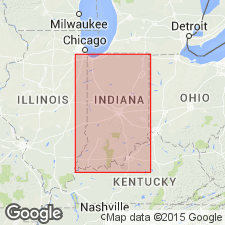
- Usage in publication:
-
- Geneva limestone
- Modifications:
-
- Areal extent
- AAPG geologic province:
-
- Cincinnati arch
Summary:
Geneva limestone. Soft dark-buff to brownish fine-grained magnesian limestone, 3 to 30 feet thick. Lies between Niagara and Jeffersonville limestones. Is = Shelby bed of Foerste, which should be abandoned. Believe Geneva limestone replaces Sellersburg and Jeffersonville to north. [Age is Middle Devonian.]
Source: US geologic names lexicon (USGS Bull. 896, p. 810).
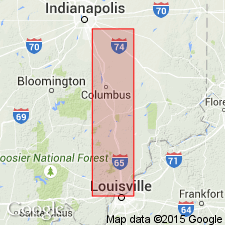
- Usage in publication:
-
- Geneva limestone
- Modifications:
-
- Areal extent
- AAPG geologic province:
-
- Cincinnati arch
Summary:
Geneva limestone, 2 to 30 feet thick, to north apparently replaces Jeffersonville and Sellersburg beds. [Age is Middle Devonian.]
Source: US geologic names lexicon (USGS Bull. 896, p. 810).
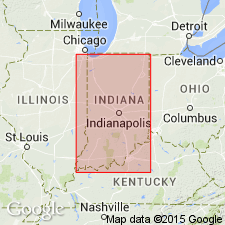
- Usage in publication:
-
- Geneva limestone
- Modifications:
-
- Revised
- AAPG geologic province:
-
- Cincinnati arch
Summary:
Jeffersonville limestone includes the Geneva limestone, Shelby beds, and Hartsville beds. [Age is Middle Devonian.]
Source: US geologic names lexicon (USGS Bull. 896, p. 810).

- Usage in publication:
-
- Geneva limestone
- Modifications:
-
- Biostratigraphic dating
- AAPG geologic province:
-
- Cincinnati arch
Summary:
Pg. 313. Fauna of Geneva limestone indicates it is of either Schoharie or Onondaga age, probably Schoharie.
Source: US geologic names lexicon (USGS Bull. 896, p. 810).

- Usage in publication:
-
- Geneva limestone
- Modifications:
-
- Areal extent
- AAPG geologic province:
-
- Cincinnati arch
Summary:
Pg. 466. Geneva limestone of Collett may represent a facies of some part of Jeffersonville. What actual relationships of Geneva and Jeffersonville-Sellersburg formations are has not been satisfactorily determined. The Geneva may be a lithologic facies of one or both of these formations, or, more likely, a distinct formation older than the Jeffersonville. Ulrich apparently correlates it with Schoharie, though his reasons are not stated. It occurs in Jennings, Decatur, Bartholomew, and Shelby Counties, central and southeastern Indiana.
Source: US geologic names lexicon (USGS Bull. 896, p. 810).
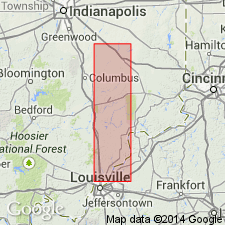
- Usage in publication:
-
- Geneva limestone
- Modifications:
-
- Overview
- AAPG geologic province:
-
- Cincinnati arch
Summary:
Geneva is northward facies of Jeffersonville formation of Onondaga age as shown by Onondaga faunules of Jeffersonville that continue into Geneva at same horizons and by lateral transition from dolomitic Geneva to purer Jeffersonville limestone. Term Jeffersonville is synonym of Geneva, and by custom of priority latter name should be applied to all IN rocks of Onondaga age.
Source: GNU records (USGS DDS-6; Reston GNULEX).
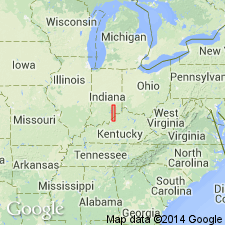
- Usage in publication:
-
- Geneva dolomite
- Modifications:
-
- Revised
- Areal extent
- Overview
- AAPG geologic province:
-
- Cincinnati arch
- Illinois basin
Summary:
Indiana Geological Survey uses name Geneva dolomite. Consists of buff to chocolate-brown granular thin-bedded to massive dolomite and contains white crystalline calcite masses that range from a fraction of an inch to more than 1 ft in cross section. Carbonaceous material is present in bands and partings. From Shelby, Rush, and Bartholomew Cos., where maximum thickness is 35 ft, Geneva thins regularly southward to its pinchout in northern Clark Co. In most places, overlies Louisville limestone, but locally overlies Waldron shale or Laurel limestone. Throughout southern IN, outcrop underlies Jeffersonville limestone. Relationship to lower Jeffersonville not clear from Jennings Co. northward, but recent data prove that middle and upper Jeffersonville maintain their characteristics throughout this are and overlie the Geneva.
Source: GNU records (USGS DDS-6; Reston GNULEX).
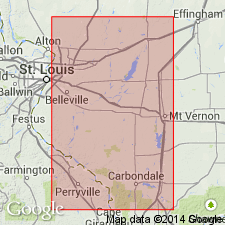
- Usage in publication:
-
- Geneva dolomite member
- Modifications:
-
- Revised
- AAPG geologic province:
-
- Illinois basin
Summary:
Geneva dolomite reduced in rank to member and assigned to Grand Tower limestone in southern IL. Age is Devonian.
Source: GNU records (USGS DDS-6; Reston GNULEX).
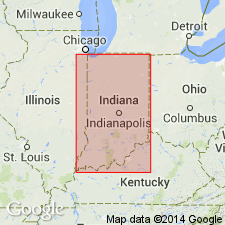
- Usage in publication:
-
- Geneva Dolomite
- Modifications:
-
- Revised
- AAPG geologic province:
-
- Cincinnati arch
Summary:
Geneva Dolomite assigned to newly named Muscatatuck Group in Indiana along with overlying Jeffersonville Limestone and North Vernon Limestone south of Kankakee and Cincinnati Arches. The Muscatatuck to the north is divided into the Detroit River and Traverse Formations. Age is Middle Devonian.
Source: GNU records (USGS DDS-6; Reston GNULEX).
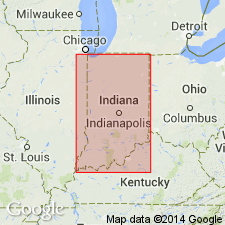
- Usage in publication:
-
- Geneva Dolomite Member
- Modifications:
-
- Revised
- AAPG geologic province:
-
- Cincinnati arch
- Illinois basin
Summary:
Geneva reduced in rank and assigned to the Jeffersonville Limestone of the Muscatatuck Group in southwestern and west-central IN. The Geneva Dolomite Member is assigned to the Grand Tower Limestone in east-central and southeastern IL. Thickness ranges from 0 to 60 ft. Age is Middle Devonian.
Source: GNU records (USGS DDS-6; Reston GNULEX).
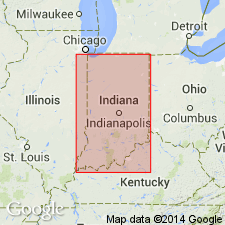
- Usage in publication:
-
- Geneva Dolomite Member
- Modifications:
-
- Overview
- AAPG geologic province:
-
- Cincinnati arch
- Illinois basin
Summary:
Two references sections designated (see above). A section designated by Burger and Patton (1970) in a quarry near Hanover, Jefferson Co. is now under water. Unit is typically a calcareous dolomite that contains bands and partings of carbonaceous material. It is massive to thick bedded in its lower part and thin bedded in its upper part. Calcified fossils are scattered through the fine-grained dolomite matrix. Conformably overlies the Dutch Creek Sandstone Member of the Jeffersonville or unconformably overlies Silurian rocks that range from the upper part of the Salamonie Dolomite to the lower part of the Wabash Formation. Underlies the Vernon Fork Member of the Jeffersonville. Ranges in thickness from 0 to more than 60 ft. Area of distribution in central and west-central IN is roughly semicircular where it is present in parts or all of about 30 counties. Age assessment and correlation are controversial. Age is Middle Devonian (early Eifelian) according to this publication.
Source: GNU records (USGS DDS-6; Reston GNULEX).
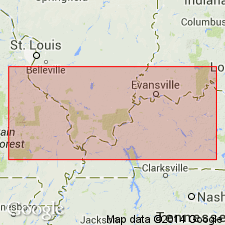
- Usage in publication:
-
- Geneva Dolomite Member
- Modifications:
-
- Overview
- AAPG geologic province:
-
- Illinois basin
Summary:
Middle Devonian Geneva Dolomite Member assigned to Grand Tower Limestone in IL where it underlies unnamed laminated dolomite beds. Assigned to Jeffersonville Limestone in IN where it underlies Vernon Fork Member. Overlies Dutch Creek Sandstone Member. Unit is 18 m thick in east-central IL.
Source: GNU records (USGS DDS-6; Reston GNULEX).
For more information, please contact Nancy Stamm, Geologic Names Committee Secretary.
Asterisk (*) indicates published by U.S. Geological Survey authors.
"No current usage" (†) implies that a name has been abandoned or has fallen into disuse. Former usage and, if known, replacement name given in parentheses ( ).
Slash (/) indicates name conflicts with nomenclatural guidelines (CSN, 1933; ACSN, 1961, 1970; NACSN, 1983, 2005, 2021). May be explained within brackets ([ ]).

